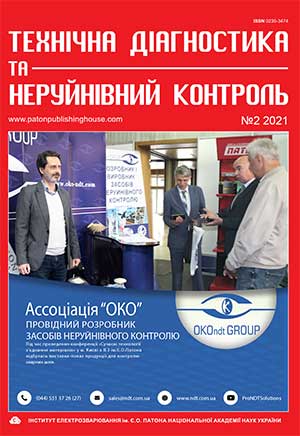| 2021 №02 (01) |
DOI of Article 10.37434/tdnk2021.02.02 |
2021 №02 (03) |

"Tekhnichna Diahnostyka ta Neruinivnyi Kontrol" (Technical Diagnostics and Non-Destructive Testing) #2, 2021, pp. 14-19
Finite element methods for assessment of the technical condition of large-sized structures from structurally heterogeneous materials (Review)
O.S. Milenin, O.A. Velikoivanenko, G.P. Rozynka, N.I. Pivtorak
E.O. Paton Electric Welding Institute of the NAS of Ukraine 11 Kazymyr Malevych Str., 03150, Kyiv, Ukraine. E-mail: office@paton.kiev.ua
Critical analysis of literature data on the methods of numerical analysis of the technical condition of large-sized structures from structurally heterogeneous materials was performed. The main advantages and disadvantages of their application for prediction of the processes, determining the quality and strength of typical structures from structurally-heterogeneous metals and composite materials, are shown within the framework of conditional division of these methods into three classes, namely macrostructural, mezostructural and multiscale. 42 Ref., 2 Fig.
Keywords: large-sized structures, heterogeneous materials, composite materials, technical condition, finite-element modeling. welded joints
Received: 07.05.2021
References
1. Gitman, I.M. (2006) Representative Volumes and Multi-scale Modelling of Quasi-brittle Materials. Proefschrift. ter verkrijging van de graad van doctor aan de Technische Universiteit Delft.2. Feng, B., Feng, X., Yan, C. et al. (2020) On the rule of mixtures for bimetal composites without bonding. Journal of Magnesium and Alloys, 8, 4, 1253-1261. https://doi.org/10.1016/j.jma.2019.11.016
3. Aboudi, J., Arnold, S.M., Bednarcyk, B.A. (2013) Micromechanics of Composite Materials. A Generalized Multiscale Analysis Approach. Oxford: Butterworth-Heinemann. https://doi.org/10.1016/B978-0-12-397035-0.00013-6
4. Moss, D.R., Basic, M. (2013) Pressure Vessel Design Manual. Oxford: Butterworth-Heinemann. https://doi.org/10.1016/B978-0-12-387000-1.00002-4
5. Kollár, L.P., Springer, G.S. (2003) Mechanics of composite structures. Cambridge University Press. https://doi.org/10.1017/CBO9780511547140
6. Sayyad, A.S., Ghugal, Y.M. (2017) Bending, buckling and free vibration of laminated composite and sandwich beams: A critical review of literature. Composite Structures, 171, 486-504. https://doi.org/10.1016/j.compstruct.2017.03.053
7. (1998) Металлические конструкции. Т.1. Общая часть. Кузнецов В.В. (ред.). Москва, Изд-во АСВ. (1998) Metal structures. Vol.1: General. Ed. by V.V. Kuznetsov. Moscow, ASV [in Russian].
8. Shokrieh, M.M., Moshrefzadeh-Sani, H. (2016) On the constant parameters of Halpin-Tsai equation. Polymer, 106, 14-20. https://doi.org/10.1016/j.polymer.2016.10.049
9. Fragoudakis, R. (2019) Strengths and Limitations of Traditional Theoretical Approaches to FRP Laminate Design against Failure. Engineering Failure Analysis. London: IntechOpen Limited. https://doi.org/10.5772/intechopen.89729
10. Li S., E. Sitnikova, E. (2020) Representative volume elements and unit cells. Concepts, Theory, Applications and Implementation. Cambridge: Woodhead Publishing. https://doi.org/10.1016/B978-0-08-102638-0.00014-1
11. Haynes, R., Cline, J., Shonkwiler, B., Armanio, E. (2016) On plane stress and plane strain in classical lamination theory. Composites Science and Technology, 127, 20-27. https://doi.org/10.1016/j.compscitech.2016.02.010
12. Sofiyev, A.H. (2019) Influences of shear deformations and material gradient on the linear parametric instability of laminated orthotropic conical shells. Composite Structures, 225, 111-156. https://doi.org/10.1016/j.compstruct.2019.111156
13. Milenin, A.S., Velikoivanenko, E.A., Rozynka, G.F., Pivtorak, N.I. et al. (2018) High-performance methods of numerical studies for solving the problems of evaluation of defective structure serviceability. Tekh. Diagnost. i Nerazrush. Kontrol, 1, 27-33 [in Russian]. https://doi.org/10.15407/tdnk2018.01.04
14. Velikoivanenko, E., Milenin, A., Popov, A. et al. (2019) Methods of numerical forecasting of the working performance of welded structures on computers of hybrid architecture. Cybernetics and Systems Analysis, 55, 1, 117-127. https://doi.org/10.1007/s10559-019-00117-8
15. Makhnenko, V.I., Milenin, A.S., Semyonov, A.P. (2007) Mathematical modeling of thermal-deformation processes in braze-welding of butt joints of the titanium-aluminium type. The Paton Welding J., 11, 2-6.
16. Trinh, M.-C., Jun, H. (2021) A higher-order quadrilateral shell finite element for geometrically nonlinear analysis. European Journal of Mechanics - A/Solids, 89, 104-283. https://doi.org/10.1016/j.euromechsol.2021.104283
17. Perić, M., Seleš, K., Tonković, Z., Lovrenić-Jugović, M. (2019) Numerical simulation of welding distortions in large structures with a simplified engineering approach. Open Phys, 17, 719-730. https://doi.org/10.1515/phys-2019-0076
18. Kharchenko, V.V., Chirkov, A.Yu., Kobel`skii, S.V., Kravchenko, V.I. (2018) Peculiarities of the Fracture Strength Design of the Branch Pipe Zone of the Nuclear Reactor Vessel. Strength of Materials, 50, 517-528. https://doi.org/10.1007/s11223-018-9997-2
19. Milenin, A., Velikoivanenko, E., Rozynka, G., Pivtorak, N. (2019) Probabilistic procedure for numerical assessment of corroded pipeline strength and operability. International Journal of Pressure Vessels and Piping, 171, 60-68. https://doi.org/10.1016/j.ijpvp.2019.02.003
20. Fudzii, T., Dzako, M. (1982) Fracture mechanics of composite materials. Moscow, Mir [in Russian].
21. Grebenyuk, S.N., Melashchenko, O.P. (2012) Application of different criteria of strength for calculation of fiber composites. Zbirnyk Naukovykh Prats KhNUPS, 3(32), 134- 136 [in Russian].
22. Panin, V.E., Korotaev, A.D., Makarov, P.V., Kuznetsov, V.M. (1998) Physical mesomechanics of materials. Russian Physics Journal, 41(9), 856-884. https://doi.org/10.1007/BF02508720
23. Haritos, G.K., Hager, J.W., Amos, A.K. et al. (1988) Mesomechanics: the microstructure mechanics connection. Int. J. Solid Structures, 24(11), 1081-1096. https://doi.org/10.1016/0020-7683(88)90007-8
24. Srivastava, V.K., Gabbert, U., Berger, H. (2011) Representative Volume Element Analysis for the Evaluation of Effective Material Properties of Fiber and Particle Loaded Composites with Different Shaped Inclusions. Mechanics of Time-Dependent Materials and Processes in Conventional and Multifunctional Materials, 3, 185-192. https://doi.org/10.1007/978-1-4614-0213-8_27
25. Panin, V. (1998) Overview on mesomechanics of plastic deformation and fracture of solids. Theoretical and Applied Fracture Mechanics, 30(1), 1-11. https://doi.org/10.1016/S0167-8442(98)00038-X
26. Saksala, T. (2018) Numerical modelling of concrete fracture processes under dynamic loading: Meso-mechanical approach based on embedded discontinuity finite elements. Engineering Fracture Mechanics, 201, 282-297. https://doi.org/10.1016/j.engfracmech.2018.07.019
27. Kanit, T., Forest, S., Galliet, I. et al. (2003) Determination of the size of the representative volume element for random composites: statistical and numerical approach. International Journal of Solids and Structures, 40, 3647-3679. https://doi.org/10.1016/S0020-7683(03)00143-4
28. Ostoja-Starzewski, M. (2006) Material spatial randomness: From statistical to representative volume element. Probabilistic Engineering Mechanics, 21, 112-132. https://doi.org/10.1016/j.probengmech.2005.07.007
29. Bargmann, S., Klusemann, B., Markmann, J. et al. (2018) Generation of 3D representative volume elements for heterogeneous materials: A review. Progress in Materials Science, 96, 322-384. https://doi.org/10.1016/j.pmatsci.2018.02.003
30. Schmauder, S., Mishnaevsky, L.Jr. (2009) Micromechanics and Nanosimulation of Metals and Composites. Berlin: Springer-Verlag https://doi.org/10.1007/978-3-540-78678-8
31. McDowell, D.L. (2008) Viscoplasticity of heterogeneous metallic materials. Materials Science and Engineering R., 62, 67-123. https://doi.org/10.1016/j.mser.2008.04.003
32. McDowell, D.L. (2007) Simulation-based strategies for microstructure- sensitive fatigue modeling. Ibid, 468, 4-14. https://doi.org/10.1016/j.msea.2006.08.129
33. Wilson, D., Dunne, F.P.E. (2019) A mechanistic modelling methodology for microstructure-sensitive fatigue crack growth. Journal of the Mechanics and Physics of Solids, 124, 827-848. https://doi.org/10.1016/j.jmps.2018.11.023
34. Makhnenko, O.V., Muzhichenko, A.F., Seyffartt, P. (2009) Application of mathematical modeling in thermal straightening of shipbuilding panels. The Paton Welding J., 1, 10-16.
35. Makhnenko, O.V., Seyffartt, P. (2008) Calculation prediction of overall distortions in laser welded beams. Ibid., 3, 6-12.
36. Makhnenko, O.V., Muzhichenko, A.F., Prudky, I.I. (2013) Mathematical modeling of stress-strain state of welded stringer panels from titanium alloy VT20. Ibid., 2, 13-9.
37. Velikoivanenko, E.A., Milenin, A.S., Rozynka, G.F., Pivtorak, N.I. (2016) Numerical prediction of effectiveness of reinforcement of defective pipelines by composite material bands. Tekh. Diagnost i Nerazrush. Kontrol, 1, 24-31 [in Russian]. https://doi.org/10.15407/tdnk2016.01.04
38. (2006) Collected Works of J. D. Eshelby: The Mechanics of Defects and Inhomogeneities (Solid Mechanics and Its Applications). Edit: X. Markenscoff, A. Gupta. Springer Netherlands.
39. Dormieux, L., Kondo, D. (2016) Micromechanics of Fracture and Damage. Vol. 1. London, ISTE Ltd. https://doi.org/10.1002/9781119292166.ch1
40. Xiaotao, L., Shan, L. (2021) A micro-crack initiation life simulation method by improving the Tanaka-Mura`s model of slip behavior. International Journal of Fatigue, 145, 106-108. https://doi.org/10.1016/j.ijfatigue.2020.106108
41. Cioranescu, D., Damlamian, A., Griso, G. (2002) Periodic unfolding and homogenization, C.R. Acad. Sci. Paris. Ser., 1(335), 99-104. https://doi.org/10.1016/S1631-073X(02)02429-9
42. McDowell, D.L., Gall, K., Horstemeyer, M.F., Fan J. (2003) Microstructure-based fatigue modeling of cast A356-T6 alloy. Engineering Fracture Mechanics, 70, 49-80. https://doi.org/10.1016/S0013-7944(02)00021-8
Advertising in this issue:
The cost of subscription/purchase order journals or individual articles
| Journal/Currency | Annual Set | 1 issue printed |
1 issue |
one article |
| TPWJ/USD | 384 $ | 32 $ | 26 $ | 13 $ |
| TPWJ/EUR | 348 € | 29 € | 24 € | 12 € |
| TPWJ/UAH | 7200 UAH | 600 UAH | 600 UAH | 280 UAH |
| AS/UAH | 1800 UAH | 300 UAH | 300 UAH | 150 UAH |
| AS/USD | 192 $ | 32 $ | 26 $ | 13 $ |
| AS/EUR | 180 € | 30 € | 25 € | 12 € |
| SEM/UAH | 1200 UAH | 300 UAH | 300 UAH | 150 UAH |
| SEM/USD | 128 $ | 32 $ | 26 $ | 13 $ |
| SEM/EUR | 120 € | 30 € | 25 € | 12 € |
| TDNK/UAH | 1200 UAH | 300 UAH | 300 UAH | 150 UAH |
| TDNK/USD | 128 $ | 32 $ | 26 $ | 13 $ |
| TDNK/EUR | 120 € | 30 € | 25 € | 15 € |
AS = «Automatic Welding» - 6 issues per year;
TPWJ = «PATON WELDING JOURNAL» - 12 issues per year;
SEM = «Electrometallurgy Today» - 4 issues per year;
TDNK = «Technical Diagnostics and Non-Destructive Testing» - 4 issues per year.











